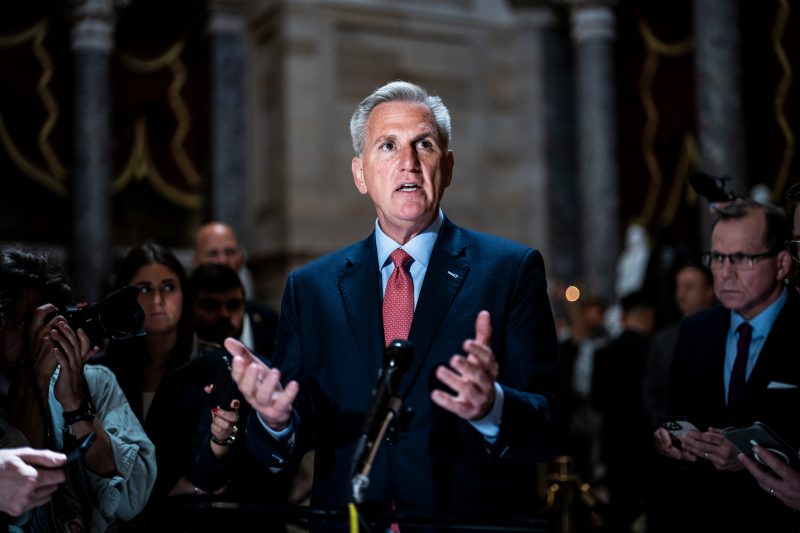“This also is the largest cut that Congress has ever voted on, more than $2.1 trillion.”
— House Speaker Kevin McCarthy (R-Calif.), in remarks on the Hugh Hewitt show on May 30
Speaker McCarthy is touting his deal with President Biden to suspend the debt ceiling with the hoary rhetoric often associated with budget deals — that this is “the largest cut” Congress has ever voted on. He then cites a specific number — $2.1 trillion.
Not all details of the deal are readily apparent, as the agreement outlines base figures but then permits adjustments that allow both sides to claim victory. An unidentified White House official, briefing reporters, claimed that after the adjustments, the deal “keeps nondefense spending roughly flat with the 2023 levels in 2024.”
McCarthy’s $2.1 trillion figure, meanwhile, comes from a preliminary Congressional Budget Office estimate leaked by GOP sources that assumes for the next six years spending caps are kept in place, even though there is no real enforcement mechanism to ensure compliance. After the last major budget deal, struck in 2011 between President Barack Obama and House Republicans, Congress had a habit of ignoring or easing such caps.
“It’s important to note that only the first two years of discretionary caps are semi-binding. The remaining four years are a gentlemen’s agreement that can be easily waived. I say semi-binding because the caps agreement leaves loopholes large enough that Congress could drive a truck through them,” said Chris Edwards, a federal-budget expert at the Cato Institute. He said the appropriations process will help determine how real the numbers are, but he said even a weak agreement is a step in the right direction because it forces Congress to shift course on spending.
Even without firm numbers in place, we can safely say that McCarthy is blowing smoke. Congress, on many occasions, has voted for deeper cuts in the past.
Let’s dig into the historical budget records maintained on the White House budget website. There’s a wealth of data there that helps put this deal into perspective.
For instance, during World War II, federal outlays soared from $9.5 billion in 1940 to $92.7 billion in 1945. But then in 1946, the outlays were reduced to $55.2 billion. That’s a cut of $37.5 billion — a reduction of more than 40 percent. The next year, 1947, the budget was cut another 37.5 percent. Then the year after that, outlays fell yet another 14 percent. (There were also cuts of 66 percent, 20 percent and 35 percent, respectively, in the three years after the end of World War I.)
This budget deal will boost defense spending, so the reductions all come in nondefense discretionary spending. Before adjustments, it appears nondefense discretionary would fall about 7 percent. But after adjustments, it’s basically flat. Because of inflation and population growth, even a flat spending curve represents a cut — but not the largest cut ever.
World wars are unique events so let’s look at another major budget deal — Ronald Reagan’s Omnibus Budget Reconciliation Act of 1981. Like this new agreement, it boosted defense spending and cut nondefense spending. The historical budget tables show that outlays for nondefense spending fell from $149.9 billion in 1981 to $140 billion in 1982 — a decline of 7 percent. Spending over the next two years ended up at 1 percent higher than 1981. The current budget deal claims it would hold spending in 2025 to just one percent.
The Reagan budget came during a period of high inflation, just like today. The historical budget tables show that outlays, when held at constant 2012 dollars, fell almost 13 percent from 1981 to 1982. In fact, in inflation-adjusted dollars, spending on nondefense programs did not return to 1981 levels until 1993, when Bill Clinton became president.
Reagan’s 1981 bill included a big defense increase that wiped out savings on nondefense programs, so it did not reduce overall spending. Measured as a percentage of the gross domestic product, the biggest deficit reduction deal in the last four decades was the 1985 Gramm-Rudman-Hollings Act, amounting to 1.72 percent of GDP, according to data assembled by Brian Riedl of the Manhattan Institute. But that law was later invalidated by the Supreme Court. Three other agreements — in 1990, 1993 and 2011 — exceeded 1 percent of GDP, Riedl said.
These estimates are based on the budget savings from spending cuts or tax hikes estimated at the time of enactment over a period of five or ten years. About half of the savings in these deals came from reducing discretionary spending. But Reidl said many of the planned cuts were later reversed.
Mark Bednar, a McCarthy spokesman, said $2.1 trillion was a preliminary CBO estimate for savings over ten years that included net interest savings from reducing the deficit if six years of budget caps remained in place. He indicated that McCarthy based his statement that this was the “largest cut” on a raw-dollar figure — “nominal dollars” — and was not adjusting the comparison to previous deals to account for inflation or to measure as a percentage of GDP.
CBO estimates that the GDP between 2024 and 2033 would total about $332 trillion. So $2.1 trillion in savings over ten years would be 0.6 percent of that figure, putting this agreement in sixth place among seven deficit-reduction agreements in the last four decades. That’s clearly not the biggest.
Late Tuesday, CBO released its official score of the bill, which shows $1.5 trillion in deficit reduction over ten years if only the first two years of caps remain in place. If that’s the case, the deal would be the smallest of the seven deficit-reduction deals.
It appears McCarthy is basing this claim simply on raw dollars. But no serious analyst would ignore the impact of inflation on budget comparisons across decades. The proper way to make such comparisons is to measure the spending reduction against the previous year’s budget, or as a percentage of the GDP or in inflation-adjusted dollars. Under none of these metrics does the current agreement end up in first place.
Given that not all of the numbers regarding this deal are clear, we can’t quite rate this as Four Pinocchios. McCarthy earns Three.
(About our rating scale)
Send us facts to check by filling out this form
Sign up for The Fact Checker weekly newsletter
The Fact Checker is a verified signatory to the International Fact-Checking Network code of principles



























